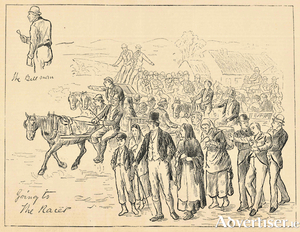Search Results for 'The Illustrated London News'
6 results found.
The Great GKC
There was a time when you would not have to remind people who GK Chesterton was. The chief proponent of beer and beefsteak Catholicism, he was the greatest polemical writer of the late 19th and early 20th century.
Wilfrid Scawen Blunt in Galway Gaol

Blunt was an aristocratic English writer, a person of remarkable ability who, as “the best looking man in England was credited with having refreshed the blood of several ancient families”. He was always against colonialism and sympathetic to small nations, so it was no surprise that he became an ardent supporter of Home Rule for Ireland. In 1887, he was in Ireland to study the grievances of the people when he heard that evictions had recommenced on the 56,000-acre estate of Lord Clanricarde in Woodford.
Traditions of the Christmas Tree
Christmas Trees as they came to be now started around the late 1400s into the 1500s. In what’s now Germany (was the Holy Roman Empire then), the Paradise Tree had more decorations on it (sometimes communion wafers, cherries and later pastry decorations of stars, bells, angels, etc. were added) and it even got a new nickname the ‘Christbaum’ or ‘Christ Tree’.
The Galway starvation riots

Our illustration today was published in the Illustrated London News on June 25, 1842, and was intended to “Convey an idea of the desperation to which the poor people of Galway have been reduced by the present calamitous season of starvation. The scene represented above is an attack upon a potato store in the town of Galway, on the 13th of the present month, when the distress had become too great for the poor squalid and unpitied inhabitants to endure their misery any longer, without some more substantial alleviation than prospects of coming harvest; and their resource in this case was to break open the potato stores and distribute their contents, without much discrimination, among the plunderers, and to attack the mills where oatmeal was known to be stored.
'Only a rale good horse can win it'

That was the answer the journalist PD Mehigan got when he asked a breeder to explain the magic of the Galway Plate some 80 years ago. An examination of the records bore out that theory for him - no bad horse, or middling horse, has ever won the Galway Plate.
The Eglinton Canal
One hundred and sixty eight years ago this week, on March 8, work started on the cutting of what we know as the Eglinton Canal. There had been previous attempts to open a passage from the river to the sea. As far back as 1498, the then mayor had a plan to connect the Sandy River with Lough Athalia. It was Alexander Nimmo who first mooted the idea of a canal in 1822. If steamboats could travel from the docks to the Corrib, it would greatly enhance the commercial importance of the city and a valuable connection with the hinterland would be established. His original plan was that this connection would start at the top of Woodquay, where McSwiggan’s is today, go along Eglinton Street and down the west side of Eyre Square to the docks. The cost proved to be prohibitive and there were a lot of objections from people who owned land or a business along the route.

